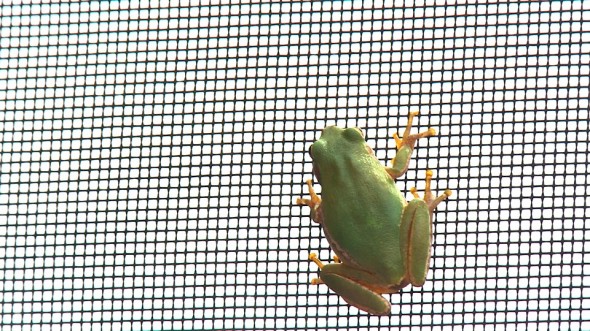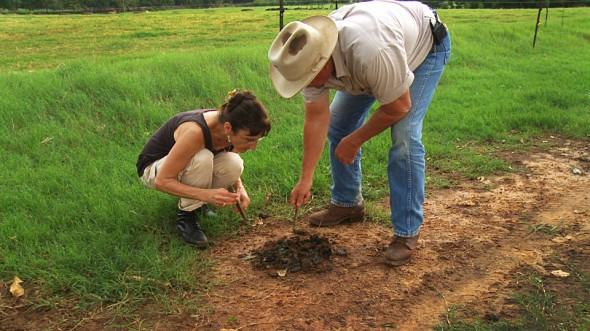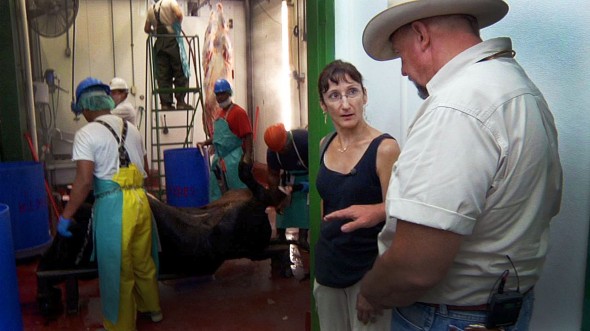Last week we visited White Oak Pastures, Will Harris’ fourth-generation farm in Bluffton, Georgia. Will raises cattle, sheep, goats, chickens turkeys, and geese. In the near future he plans to add rabbits and hogs as well. The farm is exemplary in terms of both land stewardship and humane animal handling.

This 2,500 acre farm is the largest organic farm in Georgia and the only farm in the United States that has both a beef and chicken abattoir on the property. Will’s farming methods are based on pasture rotation modeled after the natural animal migration patterns in the Serengeti Plains of Africa. At White Oak Pastures the cows graze the grass, the sheep eat the weeds, and the chickens peck at the grubs and insects. All the species naturally fertilize the land and participate in a sustainable and symbiotic ecological cycle.

As Will explained to us, he strives to work with nature, rather than against. He says, “Nature produces no waste,” quoting George Washington Carver. On White Oak Pastures all of the fertilizers for the organic crops are made right on the farm from the natural byproducts of raising and slaughtering animals.

We asked Will if raising animals was essential for sustainability, and he feels strongly that it is, saying “sustainable agriculture is about emulating nature. . . and if you’re emulating nature, animals are part of that. Nature abhors a vacuum. Nature abhors a monoculture. Nature despises one species of plant or animal occupying a space exclusively. They want a symbiotic relationship.”

It’s no wonder that White Oak Pastures received the Governor’s Environmental Stewardship Award for Agriculture from the State of Georgia in 2011. Given all of Will’s efforts toward sustainability, in addition to recycling each plant and animal byproduct on the farm, White Oak Pastures has its own water treatment plant that reuses the wash down water from the abattoirs to irrigate the crops. A 50,000 watt solar voltaic array is used to heat the water in the abattoirs and provides some of the electricity to power the processing plant.

As Will drove us around his lush, green pastures in his Jeep, he told us that he’s “a land steward and a herdsman.” We saw how respectful he is when it comes to the animals.

Will shared with us that when he first started to sell his meat from his farm directly to customers, he’d be asked how he can raise a calf or a lamb or a chick, from the day it’s born or hatched, feed it, care for it, nurture it all its life, and then kill it and skin it and gut it and eat it. His answer always was, “It doesn’t bother me a bit. This is the way things are. This is what happens.”

But he realized, “this is an unacceptable answer even though it’s true, because it sounds flippant. And it doesn’t really help that person understand the disconnect.” He thought about this reply a long time and came up with a better answer that would help connect the disconnect:

“As a herdsman, I love my herd as much as you love your pet. Just as much. But I love the herd, not the individuals in the herd. And it is absolutely essential that we slaughter these animals for nourishment in a respectful and humane way, so that another generation can be born. It’s a river not a lake.”

As we toured the farm, Will explained that cattle, pigs, sheep, goats and chickens have become food animals, and that the “most noble positioning of those animals, is to be in herds, on this farm, feeding the land that feeds them, and feeding the people that care for them. It’s a beautiful system!”

Will pointed out that the more organic a farm becomes, the more flora and fauna you will have on the farm. This frog we came across was described as “a good sign” by Will. He said that when he quit using pesticides, one of the surprises was that species of plants and animals that he remembered as a kid came back. Every day, as he transformed his farm to an organic system, he saw something new that he remembered from forty years ago.

Insects, too, are a special part of Will’s polyculture. This multiple-species habitat, in perfect balance with nature, makes the farm thrive in a way that monoculture farms controlled with pesticides and herbicides cannot. Will showed us how dung beetles dig down 18 inches to lay their eggs. Dung beetles, that help the decomposition of animal manure around the world, consume large amounts of dung as adults and larvae. They reduce pasture fouling, add nutrients to the soil, aerate the soil, and compete for nesting habitat and food resources with flies (particularly the face fly and the horn fly). Face flies can irritate cattle to the point that they lose weight from not wanting to graze. Horn flies can cause painful bleeding sores, also causing cattle to not want to eat. We’ve seen a lot of cattle over the past two years of filming, and have never seen such a large herd at this time of year without faces full of flies!

We got to see the cattle (and, of course, all of the other animals) up close and personal. Will explained that all of his animals have no idea that a human being is capable of hurting them. They’ve never been hurt by a person.

But Will clarifies that as much as he loves his herds, they are not pets. They are food animals, which is why he stresses that slaughter is an essential element of what he does. As he explains, “If you raise an animal and you can’t turn it into meat, then it’s just going to become an old and infirmed animal. And who would be benefiting from that? These animals are killed right in the prime of their life — they don’t volunteer to make that sacrifice, obviously — but what’s so wrong about that? They never suffer a day. . . they express instinctive behavior, all day long, every day. . . my food animals have a better life than most people’s pets.”

The end product of all of the efforts at White Oak Pastures with the animals is, of course, meat. The handling of meat as it is being cut from carcasses at this well-managed and pristine cutting and packing room is a sight that people are familiar with from trips to the local supermarket.

Before meat is packaged into a box like the one above, which in this case would be destined for Whole Foods Markets, the animals need to be humanely slaughtered in a USDA-inspected abattoir. Both of Will’s abattoirs, one for chicken and the other for beef, were designed by Dr. Temple Grandin, a highly respected advocate for humane handling and slaughter of farm animals for the past twenty years. Will, a true spokesperson for transparency when it comes to understanding where meat comes from and how it is processed, let us see and film in both processing plants.

For many people, the abattoir is the missing link between pasture and plate. White Oak Pastures, by having the abattoirs literally connected to the farm office, storefront, and restaurant pavilion, is a testament to how important it is to bridge the disconnect that has kept so many from the full cycle of meat production. From the dung beetle, to the frog, to the cattle grazing among the chickens, sheep and turkeys, to the humane killing of the animals, to the animal byproducts fed back into the land for the vegetables — it’s all as Will says, “a beautiful system.”

Will showed us the chicken abattoir. This facility is state-of-the-art for humane handling and slaughter. Although poultry is excluded from the Humane Methods of Slaughter Act in the United States, and it is therefore not mandatory for them to be rendered unconscious by stunning before being cut to bleed out, White Oak Pastures skillfully stuns each bird with an electrical stunning knife so it will not feel any pain. The lights are kept low in this section of the abattoir in order to keep the chickens calm. The manner in which they slaughter and process chickens at White Oak Pastures has earned their chicken a Step 5 rating from Global Animal Partnership.

Another important part of humane animal handling is the transport, unloading, and holding pen areas. As part of Dr. Temple Grandin’s design, this unloading ramp and holding pen for cattle assured that the animals stayed calm throughout the process.


The chutes that lead from the holding pen to the kill floor inside, also designed by Dr. Temple Grandin, keep the cattle from being afraid of outside distractions with the high walls. The workers were all gentle in coaxing the cattle through the chute.


Dr. Temple Grandin says “We’ve got to give animals a decent life, and when it’s time to die, a painless death. And we’ve got to give them a life that’s worth living.” Will Harris stays true to these humane standards every step of the way. This is just one of the many reasons that all of the meat from White Oak Pastures is approved by Certified Humane and Animal Welfare Approved. It is also part of Global Animal Partnership’s 5-Step Animal Welfare Rating Standards program.


When we saw the kill floor in the beef processing plant, Will carefully explained all of the details of both food safety and humane slaughter. Getting a better understanding of how slaughter is done here and being able to see the process first-hand, illuminates how Will respects the animals. This respect, as we learned throughout our time at White Oak Pastures, reveals the special character of White Oak Pastures and everyone working there.

During lunch time we joined Will and his workers at the Pavilion, where employees are served a hot lunch consisting of fresh vegetables and beef or chicken which was raised and processed on the farm. In every way, White Oak Pastures provides a living example of the future of sustainable agriculture, humane animal handling, and positive work environments, all components of an integrated whole, bringing us back to harmony with nature.

